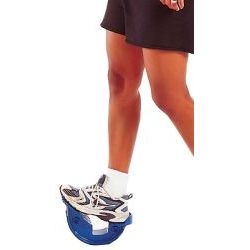
How fun it is this week to write about our very successful New Product Showcase! As you know from the build-up, we held this event on Tuesday, June 3, and Pam and I are still making our way through all the great feedback we received from the many folks who attended. We had a full house!
First of all, our deepest thanks to those of you who participated as testers. We appreciate your time, attention and terrific perspectives. Your generosity and input help me and Pam find the right products and offer them at the right time. You are what makes Capabilities all that it is!
Secondly, we thank the vendors and inventors who agreed to come to our event and showcase your products. It’s one thing to have to convince people like me and Pam. You have plenty of practice doing that. It’s quite another to be in a roomful of customers and potential customers who can tell you right away if you are barking up the wrong tree or not. Sharing your evening with us all made a big difference!
We have lots to write about regarding the products themselves. I’ll give you an overview in this blog and write individually about some of the products and the specific feedback in the coming days and weeks. We are certain to take on a number of these products after the great reception they received by our customer-testers.
We wanted the product list to be varied and we certainly achieved that end. For example, we featured copper sheets! These are comfy, ordinary looking sheets with microscopic copper threads woven in to give the sheets antimicrobial properties. Whether you are in bed the usual 7 or 8 hours or must spend more time due to an illness or injury, we all know that the warm environment between sheets is host to lots of bacteria. While most bacteria is just fine, the more we learn about ways to dissipate it, the more options we have for ensuring that we stay healthy…or get back on the road to health if we are battling something that will not do well in a bacterial environment. These sheets wash and dry normally and their copper threads will not wear out.

We invited Eschenbach, a world leader in the manufacture of vision products, to attend to feature their newest products. As you know, we already carry a wide selection of magnifiers manufactured by Eschenbach. The “temple glasses” are perfect for us Boomers who need “cheaters” tucked away in every corner of the house and car. These tiny, but powerful glasses, take up very little room, can hang from a cell phone (I always need my glasses to see the screen!), or a purse. They slip easily onto your face, stopping just around the temples. They are truly meant for the quick on and off to see something in the moment.
The folks from Light for Health brought simple light bulbs that emit full spectrum light. They are an easy way to transform your work or leisure space into well-lighted zones that assist your vision, not to mention provide much needed access to that full spectrum light while you are indoors.

Local inventor, Bill Tyree of Tyree Designs, brought his grown up tricycle that he uses for everyday errands. He stores it in his truck and pulls it out when he gets to where he is going so as not to drive to every store and hitching post. Its simple design makes it easy to maintain and repair, not to mention the low cost. Folks had fun test driving this vehicle…outside the store. It has a lot of speed for a small thing!
A product brand new to the marketplace is Meddock, a slick way to keep your medical and personal records at your fingertips. The team at Meddock help you compile your data onto a simple jump drive that you can wear around your neck or keep in your pocket. It is password protected. Here’s the great part. If you are injured or unable to tell anyone your password, there is a phone number to call right on the stick drive. With identifying information the folks treating you can explain to the customer service people at Meddock and gain access to your information 24 hours a day. The peace of mind this tiny tool brings is remarkable!
Fractiles have been around for a while. Created right here in Colorado, these magnetic tiles garnered the prestigious Parents’ Choice Award for play and educational value, quality and design. We like them because they are one more simple tool for our focus on brain fitness. Creating dynamic designs with these easy to manipulate tiles both challenges and entertains.
The About Face Remote is still at the prototype stage. We featured it at our showcase because we learned about it at the conference on aging we wrote about last year. We met its creator, Kim McRae, who was inspired to create this simple remote as she has cared for her mother at all stages of Alzheimer’s Disease. The unique aspect of this remote is that the buttons are arranged to mimic the human face. The eyes control the channels (up and down only). The ears have volume control (up and down only). The mouth controls on and off. The human face is universally recognized and even with the ravages of Alzheimer’s, individuals do still recognize the shape of the human face. The simple to use and highly intuitive button placement also make it a great tool for kids and others who are learning or relearning to control some of the universe around them. Kim was just named a finalist in the Silicon Valley Baby Boomer Business Summit, a forum for entrepreneurs to pitch their business models for investment funding. All the best to Kim and her team at About Face as she moves forward.
We invited back Bob Williams, inventor of unique and highly functional wheelchair handles. This product, also still in prototype phase, is one of those things that you see and cannot imagine why they have not long ago been developed. Meant to slip onto a standard wheelchair handle, these grips can adjust 360 degrees providing more comfortable positions when pushing a wheelchair. Especially useful for those with weak grip (many of us over the age of 50, I think!), they are a tool that everyone who has maneuvered a wheelchair can use. I recently worked with someone who was well over 6’5” who had an aching back from pushing his mother in a wheelchair, so stooped over was he trying to drive the thing. These handles cock upwards to provide a taller gripping surface. Bob is presenting to various manufacturers and we wish him good luck in bringing these great devices to market.
Last, but not least, we also featured, as we did last year at our New Product Showcase, a product we already carry that we think is quite innovative. We have written her before of our Mobile Art collection, inspired by the creations of local artist, Amy Vicioso. Amy came with her latest iterations of hand painted canes, using color and symbols for healing and those associated with first names. It’s a whole new way to decorate your mobility equipment in meaningful ways. Amy has also created our Capabilities label of crutch covers, designed with extra layers of comfy foam and wonderful colors. Her latest additions are sure to please the young crowd, in particular. Camo and Skulls + Crossbones! We have already sold out of these styles a few times in the past few weeks. Amy is working on brand new product that we will release under the Capabilities label this month. Stay tuned! (The folks at the New Product Showcase got a sneak preview and raved! In fact, one of our customer-testers helped Amy solve the last tiny issue was working on in the design! Thanks so much.)
So, I hope I have tweaked your curiosity a bit more about these products. Stay tuned for more details on them, including some of the feedback from our testers. We will let you know which products we start carrying and when, giving them their due in these pages online.
Once again, Pam and I are so grateful to all of you who participated and made this event such a terrific success! We will most certainly host another one in the future!
 Janska Clothing is a wonderful addition to our line up because of its ease of use, style and choice of color and sizing. You can see a sample of this terrific clothing here and a full selection at our flagship store. We also have a collection of clothing protectors for adults and children that provide a dignified alternative to bibs while eating. And we just added a big selection of slipper socks and other easy to wear footwear to ensure both comfort and safety while moving around your home.
Janska Clothing is a wonderful addition to our line up because of its ease of use, style and choice of color and sizing. You can see a sample of this terrific clothing here and a full selection at our flagship store. We also have a collection of clothing protectors for adults and children that provide a dignified alternative to bibs while eating. And we just added a big selection of slipper socks and other easy to wear footwear to ensure both comfort and safety while moving around your home.












